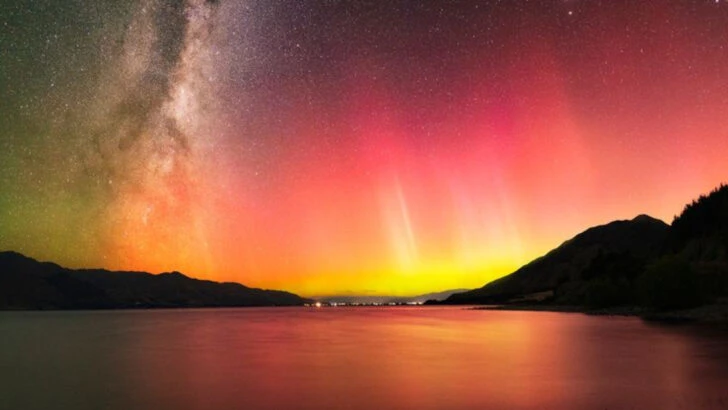The Southern Lights, or Aurora Australis, are a mesmerizing natural phenomenon. They are created by solar particles interacting with Earth’s magnetic field, similar to their northern counterpart. Despite being less known and harder to spot due to their appearance near the Antarctic Circle, the Southern Lights offer a unique and intimate viewing experience. Spectators can enjoy vibrant displays in remote locations like Tasmania and New Zealand, away from bustling tourist crowds. These natural light shows are not only a photographer’s dream but also hold cultural significance for indigenous communities while presenting an enduring scientific mystery.
What Are the Southern Lights?
Known as Aurora Australis, the Southern Lights are nature’s own light display, created as solar particles collide with Earth’s magnetic field. This cosmic dance paints the sky with luminescent hues of green, pink, and sometimes purple. The process mirrors that of the Northern Lights, occurring at the polar opposite of the planet.
Witnessing this phenomenon requires a journey to the Southern Hemisphere, where the sky becomes a canvas of celestial art. Unlike the widely recognized Northern Lights, the Southern Lights remain a hidden gem, waiting for adventurers to uncover their mystical allure.
Harder to See, But Worth the Effort
Unlike the more accessible Northern Lights, the Southern Lights are elusive. Visible mostly from remote areas near the Antarctic Circle, they require effort and dedication to witness. This rarity, however, adds to their mystique and allure, making the journey worthwhile.
Travelers seeking these lights embark on adventures to secluded spots with minimal light pollution. The solitude and serenity of these locations provide a perfect contrast to the vibrant auroras, creating an intimate and memorable experience for those who make the trek.
Just as Colorful and Dramatic
The Southern Lights offer a spectacle that’s equally as colorful and dramatic as their northern siblings. Shades of green, pink, purple, and even red light up the sky in a mesmerizing display. Conditions need to align perfectly, but when they do, the result is breathtaking, like a masterpiece painted in the heavens.
These vivid displays serve as a reminder of the world’s natural beauty, offering a scene that feels both otherworldly and deeply connected to the Earth. It’s nature’s own light show, waiting to be watched in awe.
Best Viewing Spots Include Tasmania and New Zealand
For those eager to see the Southern Lights, Tasmania’s south coast and New Zealand’s Otago Peninsula are top picks. These locations offer pristine night skies, southern-facing ocean views, and low levels of light pollution, ideal conditions for aurora enthusiasts.
In these spots, the universe reveals its secret wonders. The tranquility and natural beauty provide an unforgettable backdrop to the dancing lights above. Away from city lights and busy tourists, these locations offer a rare chance to connect with nature’s wonders in peaceful solitude.
Less Crowded, More Intimate Experiences
While Northern Lights tourism has become a bustling industry, the Southern Lights offer a quieter alternative. Destinations near the Antarctic Circle are less crowded, providing a more intimate experience with nature’s light show.
Imagine watching the auroras in solitude, with just the sound of the wind and the ocean. These experiences feel like a private spectacle, reserved for those who seek the road less traveled. The absence of bustling tour groups allows for a deeper personal connection to the natural world, making the experience truly special.
Visible All Year (But Especially in Winter)
The Southern Lights can be seen throughout the year, but winter offers the most promising conditions. With long nights and clear skies, the chances of witnessing this spectacle increase significantly.
Winter in the Southern Hemisphere, spanning May to August, provides an extended window for aurora viewing. The crisp, cold air and the extended darkness create an ideal setting for the lights to perform their celestial ballet. It’s a time for adventurers to bundle up and immerse themselves in this ethereal experience, wrapped in a cloak of stars and auroras.
Photographers’ Hidden Gem
For photographers, the Southern Lights are a hidden treasure. The southern skies offer stunning compositions with the auroras, stars, and unique landscapes all in one frame. The stillness and symmetry of the scene create perfect conditions for capturing breathtaking images.
Few know about this gem, making it a dream destination for those passionate about night photography. The challenge of capturing the ephemeral beauty of the auroras is matched by the reward of a perfect shot. It’s an opportunity to blend creativity with nature, resulting in images that inspire and captivate.
Linked to Southern Skies and Star Clusters
One of the most breathtaking aspects of seeing the Southern Lights is the celestial show that comes with them. Unlike the Northern Hemisphere, the southern night sky features constellations that many travelers rarely get to see—like the Southern Cross, which has guided explorers for centuries, and the two glowing Magellanic Clouds, which are actually neighboring dwarf galaxies.
When these southern constellations appear alongside shimmering auroras, the result is a surreal, layered view of the universe. It’s not just an aurora—you’re witnessing one of the most unique skyscapes on Earth.
Cultural and Indigenous Significance
The Southern Lights aren’t just beautiful—they’re deeply meaningful to the people who have lived under them for generations. In Māori culture, they’re known as Tahu-nui-a-rangi, which translates to “great glowing of the sky,” and are often seen as a connection to ancestors and spiritual realms.
In Aboriginal Tasmanian traditions, the lights have been described in stories as fires in the spirit world or signs from the heavens. These interpretations reflect a long-standing relationship with the land and sky—one that adds emotional depth to the experience of watching the aurora dance overhead.
Just as Scientific, Still Mysterious
We know the basics: auroras are caused by charged particles from the sun interacting with Earth’s magnetic field. But beyond that, predicting exactly when and where the Southern Lights will appear is still an inexact science.
Unlike the Northern Lights, which benefit from more observation stations and public forecasting tools, the Southern Lights are less studied and harder to track. This makes each sighting feel rare and spontaneous, adding to the sense of wonder. Even with all our modern tools, the sky still has its secrets.
A Bucket List Experience—Without the Hype
Everyone talks about chasing the Northern Lights—but the Southern Lights offer the same jaw-dropping beauty without the lines, crowds, or overbooked resorts. There are no massive tour buses lining up in the night, no stampedes for the perfect selfie spot.
Instead, watching the aurora australis often feels intimate and personal, whether you’re standing on a remote Tasmanian beach or bundled up in the hills of New Zealand. For those willing to travel a little further and wait a little longer, the reward is an experience that feels private, magical, and genuinely unforgettable.

